West Bengal, a land steeped in history, culture, and vibrant traditions, beckons travellers with a rich tapestry of the past. From the grand remnants of the British Raj to the ancient capitals of powerful dynasties and spiritual centres that shaped philosophical thought, exploring the historical places in West Bengal is like walking through living history books. This eastern Indian state has witnessed empires rise and fall, colonial powers assert their dominance, and cultural renaissances flourish, leaving behind an incredible legacy etched in stone, brick, and memory.
For anyone fascinated by the echoes of yesteryear, delving into the diverse collection of historical places in West Bengal offers an unparalleled experience. Each site tells a unique story, reflecting different eras, architectural styles, and the lives of people who shaped this region. Forget dry textbooks; these locations bring history to life, allowing you to touch the walls that stood through centuries, walk the paths trodden by historical figures, and soak in the atmosphere of bygone times. Whether you’re a history buff, an architecture enthusiast, or simply a curious traveller, these historical places in West Bengal promise a journey filled with discovery and awe.
Let’s embark on this fascinating exploration and uncover 10 must-visit historical places in West Bengal that deserve a prime spot on your itinerary.
1. Victoria Memorial Hall, Kolkata: A Crown Jewel of the Raj
Standing majestically on the Maidan in Kolkata, the Victoria Memorial Hall is perhaps one of the most iconic and widely recognized of all the historical places in West Bengal. This grand white marble structure was built between 1906 and 1921 in memory of Queen Victoria, who reigned as Empress of India from 1876 to 1901. Conceived by Lord Curzon, the then Viceroy of India, the memorial is a striking example of Indo-Saracenic architecture, a style that blended British and Mughal elements with touches of Venetian, Egyptian, and Deccani influences.
The design was primarily the work of William Emerson, with Vincent Esch assisting in the architectural details and designing the gardens. Constructed from the same Makrana marble used for the Taj Mahal, the Victoria Memorial exudes a sense of timeless elegance and grandeur. Its central dome is topped by a striking bronze figure of the Angel of Victory, which occasionally rotates with strong winds. Surrounding the dome are allegorical sculptures representing Art, Architecture, Justice, and Charity, while the North Porch features figures depicting Motherhood, Prudence, and Learning.
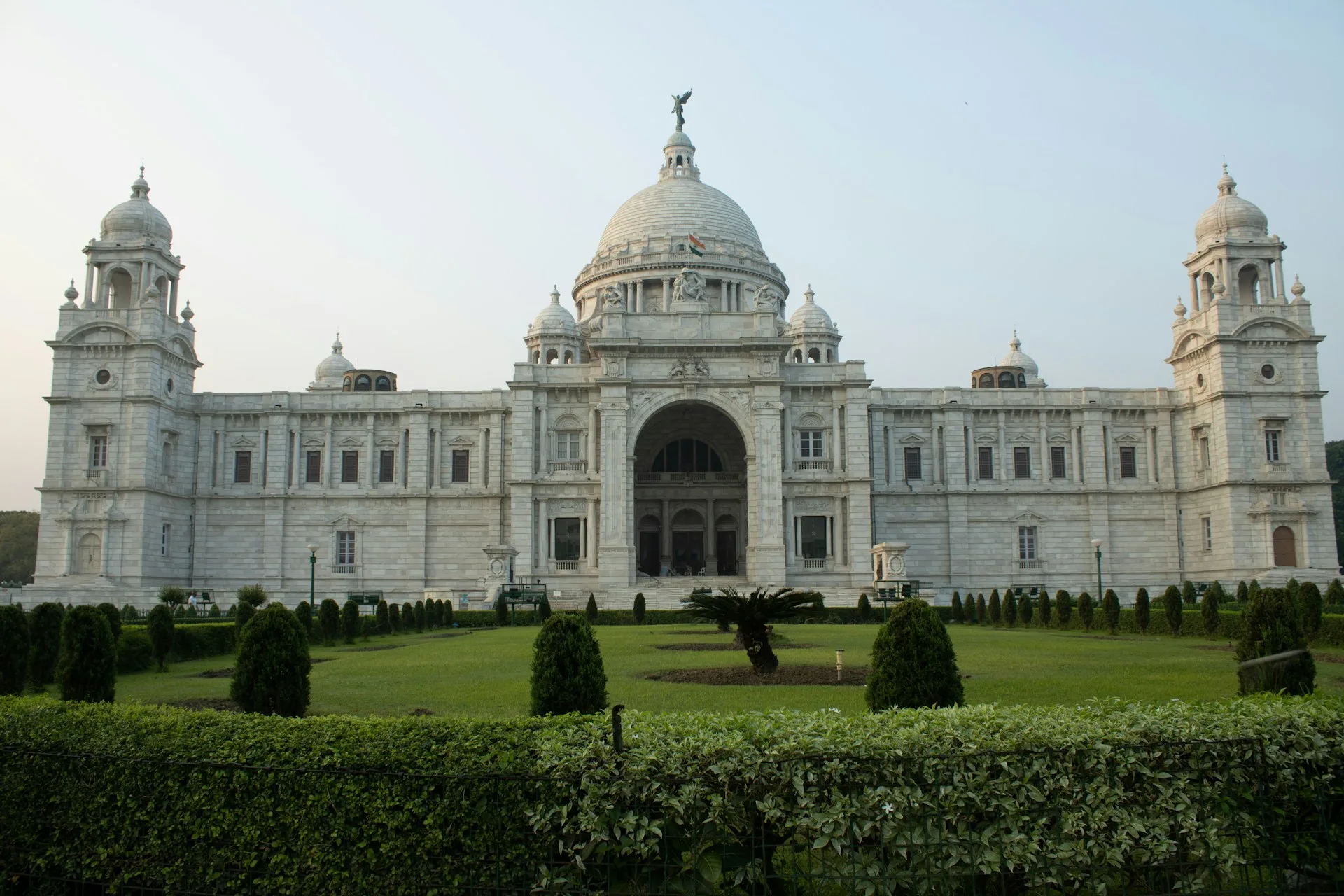
More than just a monument, the Victoria Memorial functions as a museum housing an extensive collection of artefacts from the British Raj era. Inside, you’ll find galleries dedicated to Calcutta’s history, portraits of British royalty and Indian nationalist leaders, paintings, sculptures, weapons, textiles, and stamps. The collection provides valuable insights into the political, social, and cultural history of India during the colonial period. Walking through the galleries, you can almost hear the whispers of history, understanding the complex relationship between India and the British Empire.
The surrounding gardens, designed by Lord Redesdale and David Prain, span 64 acres and offer a serene escape from the bustling city. Dotted with statues of prominent figures like Lord Curzon, Robert Clive, and others, the gardens themselves are part of the historical narrative. Visiting the Victoria Memorial is essential for understanding the colonial chapter of India’s past and appreciating the architectural prowess of the era. It’s a place where history, art, and nature converge beautifully, making it one of the foremost historical places in West Bengal to explore.
2. Hazarduari Palace, Murshidabad: The Palace of a Thousand Doors
Journey north from Kolkata to Murshidabad, a city that served as the capital of Bengal under the Nawabs. Here lies the magnificent Hazarduari Palace, meaning “Palace with a Thousand Doors,” another gem among the remarkable historical places in West Bengal. Built between 1824 and 1838 by Nawab Nazim Humayun Jah, the palace was designed by Colonel Duncan McLeod in a captivating Neoclassical Italianate style, characterized by its symmetrical façade, grand columns, and imposing presence.
The palace truly lives up to its name, featuring 1,000 doors, though interestingly, 100 of these are false, cleverly constructed to confuse potential intruders – a fascinating detail that adds a touch of intrigue to this historical site. Standing three stories high on a vast 41-acre complex known as Kila Nizamat, the palace boasts 114 lavishly decorated rooms. These include a Durbar Hall where the Nawab held court, a grand banqueting hall, drawing rooms, and libraries, all showcasing the opulence and lifestyle of the ruling class.
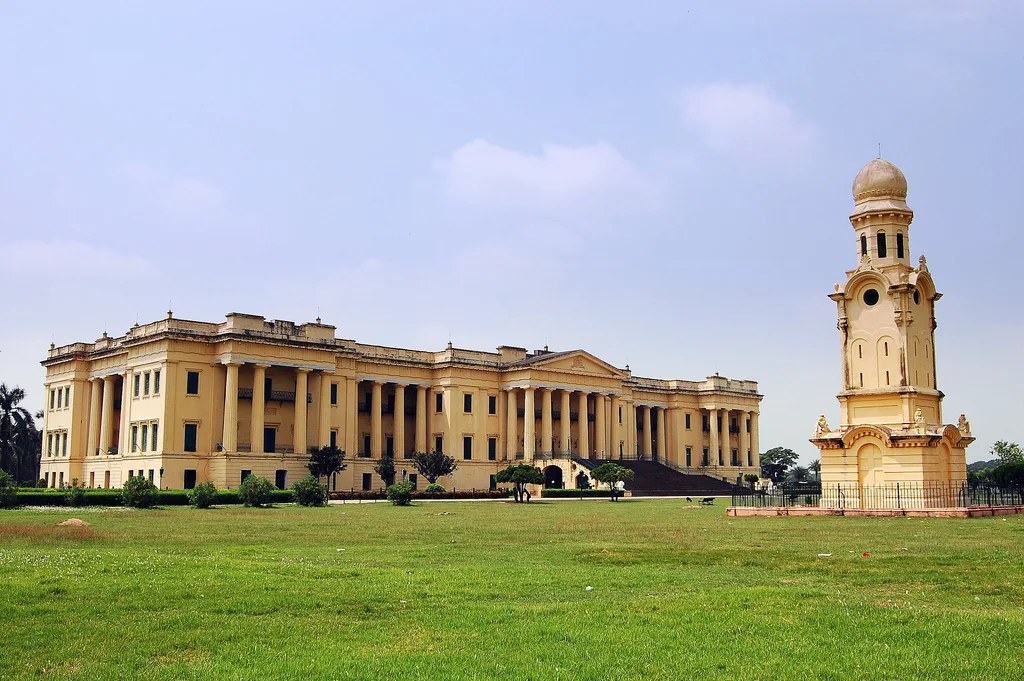
Today, Hazarduari Palace is a museum managed by the Archaeological Survey of India (ASI). It houses an incredible collection of artefacts belonging to the Nawabs, offering a glimpse into their lives and times. You can see exquisite paintings, antique furniture, elaborate chandeliers (including one famously designed for a thousand candles, now fitted with 96 lights), mirrors, weapons, and other personal belongings. One particularly intriguing exhibit is a ‘secret mirror’ strategically placed to allow the Nawab to see everything happening in the hall without being seen himself.
Exploring the palace is a journey back to the era of the Nawabs, a time of both grandeur and eventual decline. The sheer scale of the building and the richness of its contents speak volumes about the power and wealth concentrated in Murshidabad. The complex also includes other historical structures like the Nizamat Imambara and the Footi Mosque, making the entire area a treasure trove of historical places in West Bengal. A visit here is vital for understanding the pre-colonial political landscape of Bengal.
3. Bishnupur Terracotta Temples, Bankura: Artistry in Clay
In the Bankura district of West Bengal lies Bishnupur, a town renowned for its unique terracotta temples, built by the Malla rulers between the 17th and 18th centuries. These temples are not just religious structures but also remarkable examples of the region’s distinct architectural style and artistic excellence. They are undoubtedly some of the most culturally significant historical places in West Bengal.
The Malla kings were Vaishnavites and dedicated these temples primarily to Lord Krishna. What sets them apart is their construction material – laterite stone and richly ornamented terracotta tiles. The terracotta panels adorning the temple walls are intricate and captivating, depicting scenes from the Hindu epics like the Ramayana and Mahabharata, as well as mythological tales, daily life, and animal motifs. The level of detail and craftsmanship in these carvings is simply astonishing, showcasing the skill of the artisans of that time.
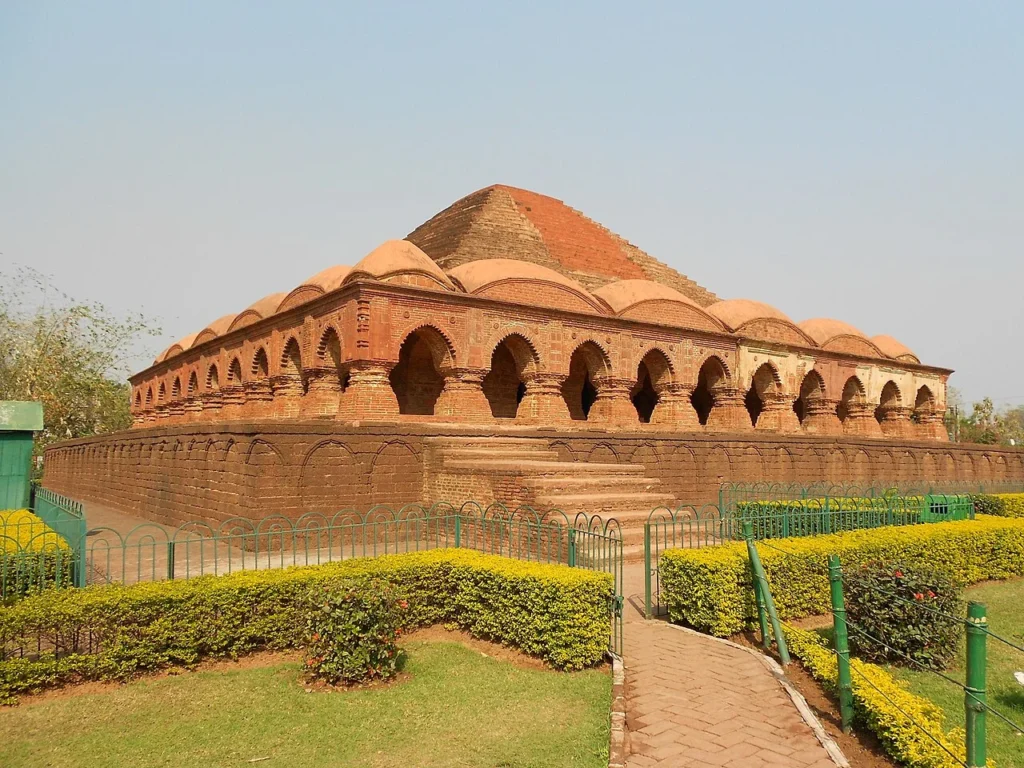
Several notable temples stand in Bishnupur, each with its own architectural style. The Rasmancha, a unique pyramidal structure, was built to host the annual Ras festival where idols from other temples were brought together. The Jor-Bangla Temple, with its distinctive twin hut-like structures joined together, is famous for its elaborate terracotta friezes. The Shyam Rai Temple, a Pancha Ratna (five-towered) temple, is another masterpiece of terracotta art. The Madan Mohan Temple, an Ek Ratna (single-towered) structure, is also richly decorated.
These temples reflect a blend of traditional Bengali roof styles (like the Chala style resembling thatched huts) and other regional influences. They stand as a testament to the artistic and religious fervor of the Malla dynasty and offer a unique insight into the cultural history of Bengal. Walking among these ancient structures, marveling at the stories etched in clay, provides a deeply enriching historical and artistic experience. The Bishnupur terracotta temples are truly indispensable among the must-see historical places in West Bengal.
4. Gaur and Pandua, Malda: Echoes of Ancient Capitals
In the Malda district of North Bengal lie the ruins of Gaur and Pandua, two ancient cities that successively served as the capitals of Bengal under various dynasties, including the Hindu Senas and the Muslim Sultans. Exploring these sprawling ruins offers a glimpse into the region’s deep historical roots, stretching back to the 5th century BC. These sites are among the most significant, though perhaps less frequented, historical places in West Bengal.
Gaur (also known as Lakhnauti or Jannatabad) was a prominent capital for over a thousand years, reaching its zenith during the Bengal Sultanate period (1453-1565). At its peak around 1500, Gaur was one of the most populous cities in the world. The Sultans built a citadel, palaces, mosques, gates, and extensive infrastructure like canals and bridges. The surviving structures, though largely in ruins, include impressive mosques like the Adina Mosque (located in nearby Pandua, but historically linked as the Sultanate’s first capital) and the Firoz Minar, a victory tower. Other notable ruins in Gaur include the Dakhil Darwaza (an imposing gateway), the Baro Shona Mosque (Golden Mosque), and the Qadam Rasul Mosque.
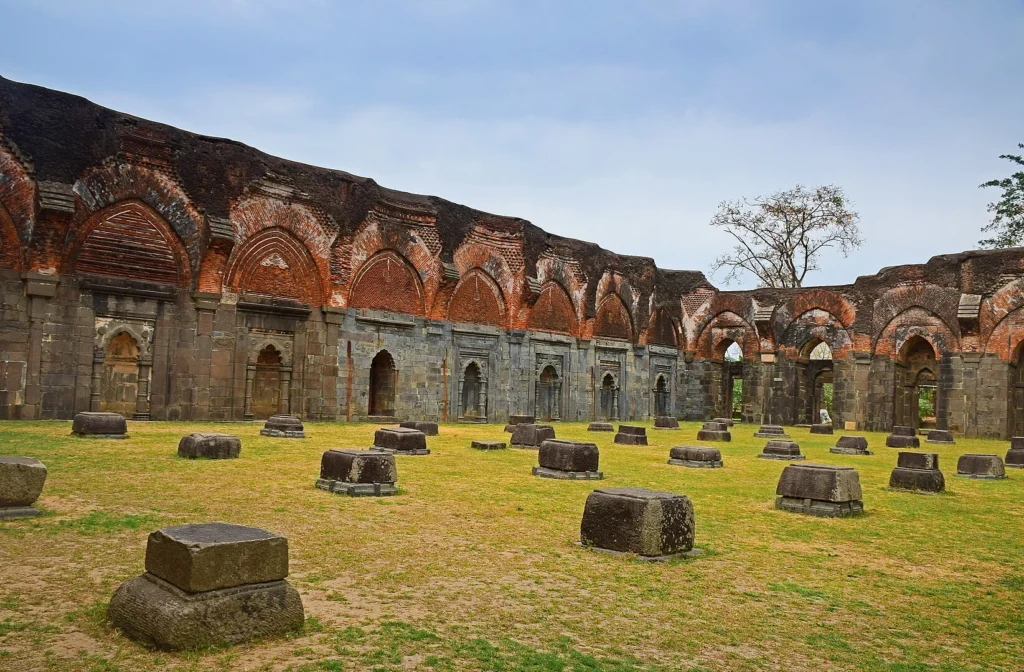
Pandua served as the capital before Gaur. The Adina Mosque in Pandua, built by Sultan Sikandar Shah in the late 14th century, is one of the largest mosques in the Indian subcontinent and a spectacular example of Sultanate architecture, albeit in a state of partial ruin. Its sheer scale and intricate mihrabs are awe-inspiring.
Walking through the vast, sometimes overgrown, archaeological sites of Gaur and Pandua requires imagination to fully appreciate their past glory. These ruins tell a story of political shifts, architectural evolution, and the fusion of cultures. They are a vital link to Bengal’s medieval past and represent some of the most compelling ancient historical places in West Bengal. Visiting them provides a tangible connection to the dynasties that once ruled this fertile land.
5. Fort William, Kolkata: A Military Legacy
Located on the eastern bank of the Hooghly River in Kolkata, Fort William is a massive fortification that stands as a powerful symbol of British military presence in India. Unlike many historical forts that are now museums, Fort William remains an active military base, serving as the headquarters of the Indian Army’s Eastern Command. While public access is restricted to certain areas like the Vijay Smarak (War Memorial) and the museum inside, its historical significance is undeniable, making it one of the crucial historical places in West Bengal.
The fort’s history is intertwined with the British East India Company’s rise to power. The original Fort William was built starting in 1696 near the site of the present GPO (General Post Office) and was completed around 1706. However, following the attack by Nawab Siraj-ud-Daulah in 1756 (which led to the infamous “Black Hole of Calcutta” incident, though the historical accuracy and scale of this event are debated), the British decided to build a new, larger, and more defensible fort. Construction of the current Fort William began in 1758, after the Battle of Plassey, under the direction of Robert Clive, and was largely completed by 1781.
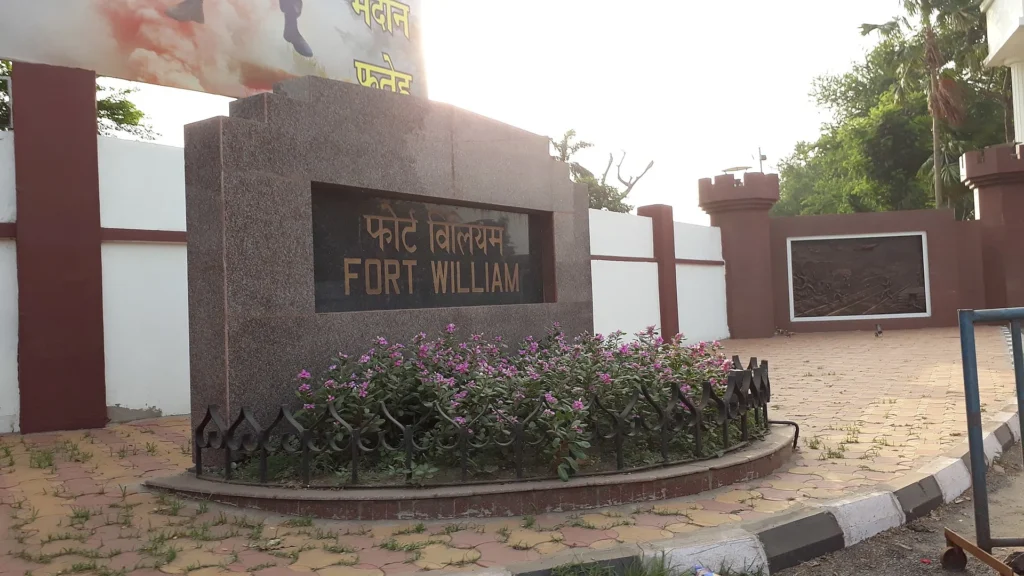
The new fort was built in the shape of an irregular octagon, a design characteristic of star forts intended to defend against cannon fire. A wide dry moat surrounds the fort, designed to trap attackers. The fort has six gates: Chowringhee, Plassey, Calcutta, Water Gate, St. George’s Gate, and Treasury Gate. The area around the fort was cleared to provide a clear line of fire, creating the vast open space known as the Maidan, often referred to as the “lungs of Kolkata.”
While you cannot freely wander the entire fort complex due to its operational status, its exterior, the Maidan, and the accessible war memorial provide a strong sense of its historical importance. It served as a vital military and administrative centre during the British Raj, coordinating troops during various conflicts. Fort William represents the military might that underpinned colonial rule and is a significant, albeit partially inaccessible, part of the historical places in West Bengal.
6. Katra Mosque, Murshidabad: A Nawab’s Legacy and Resting Place
Also located in Murshidabad, just a short distance from Hazarduari Palace, stands the Katra Mosque, another historically important structure from the Nawab era. Built by Nawab Murshid Quli Khan, the founder of Murshidabad as the capital of Bengal, Bihar, and Orissa, this mosque complex was completed around 1724-1725. It served not only as a place of worship but also as a large caravanserai and a madrasa (Islamic school), designed to accommodate hundreds of Quran readers. This multifaceted purpose makes it one of the intriguing historical places in West Bengal.
The architecture of the Katra Mosque reflects a blend of Mughal and Bengali styles. Built on a high platform, the mosque features a large central courtyard surrounded by double-storied domed cells that housed students and travellers. The most striking features are the two massive corner towers with loopholes, which once stood taller but were partially damaged by the earthquake of 1897. These octagonal minarets were about 70 feet high, and climbing to the top offered panoramic views of the city.
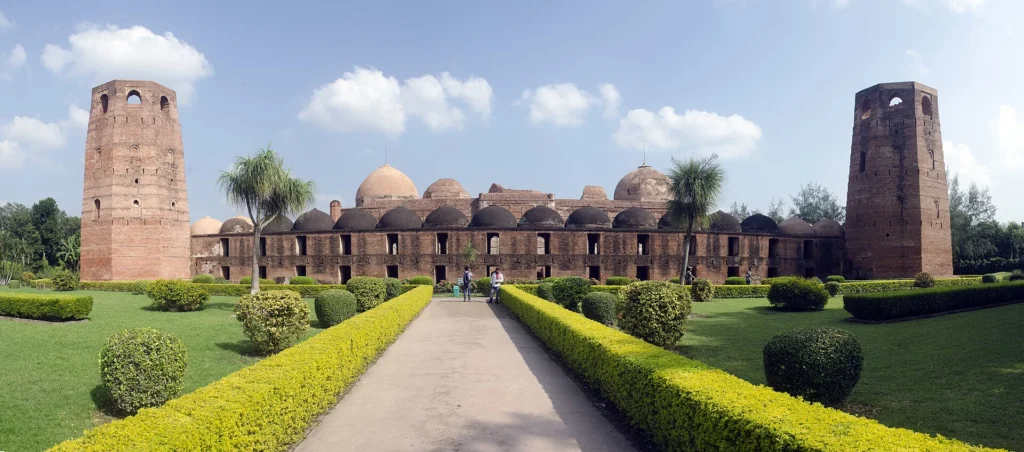
One of the most poignant historical aspects of the Katra Mosque is the tomb of its founder, Nawab Murshid Quli Khan. According to his dying wish, he was buried under the staircase of the main entrance to the mosque. This was an act of humility and penitence, as he desired that the dust from the feet of those entering the mosque would fall upon his grave, seeking spiritual merit. This unique burial site adds a deeply human element to the historical narrative of the place.
Although partially in ruins, the Katra Mosque retains a powerful sense of history and spiritual tranquility. It stands as a testament to the religious and architectural patronage of Murshid Quli Khan and offers valuable insights into the urban and religious life of 18th-century Murshidabad. As one of the key historical places in West Bengal related to the Nawab period, it’s a site that evokes contemplation on life, death, and devotion.
7. Cooch Behar Palace, Cooch Behar: A Royal Residence in the North
Heading towards the northern part of the state, in the city of Cooch Behar, stands the majestic Cooch Behar Palace, also known as the Victor Jubilee Palace. This grand palace was built in 1887 during the reign of Maharaja Nripendra Narayan of the Cooch Behar State. Its design is inspired by classical Western architecture, particularly resembling Buckingham Palace in London and featuring a dome similar to that of St. Peter’s Basilica in Vatican City. This blend of European architectural styles sets it apart from many other historical places in West Bengal.
The palace is a double-storied brick structure covering a substantial area, showcasing elegance and grandeur. The façade features a series of arcaded verandahs on both floors, with alternating single and double rows of piers. The central part of the palace projects slightly, leading to a porch that provides entrance to the Durbar Hall, the ceremonial centre of the palace. The highlight of the palace’s architecture is its elegant metal dome, standing prominently at 124 feet above the ground, in the style of Renaissance architecture. The dome’s interior is intricately carved, and Corinthian columns support its base.
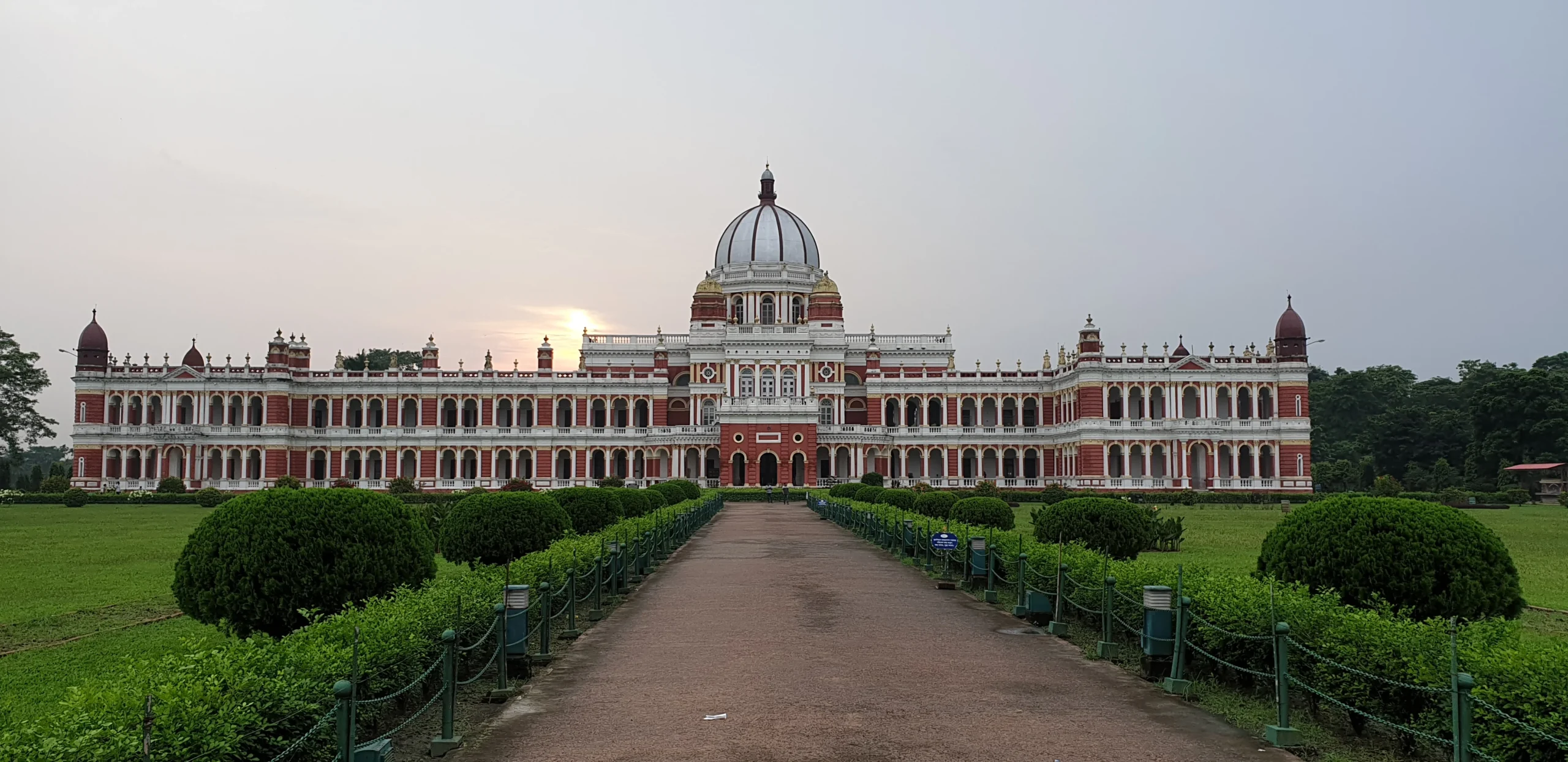
The palace was the seat of power for the Koch dynasty, who ruled the princely state of Cooch Behar. After the integration of the state into India, the palace became a protected monument and was converted into a museum under the ASI. The museum houses artefacts from the royal family, including furniture, clothing, paintings, weapons, and other personal effects, offering a glimpse into the lifestyle of the Maharajas.
The Cooch Behar Palace represents a relatively later phase of regional history, showcasing the wealth and European influences adopted by the princely states during the British Raj. It’s a beautiful architectural marvel and an important reminder of the diverse political entities that existed in India before independence. Exploring its halls and grounds is a journey into the life of royalty, making it a significant addition to the list of historical places in West Bengal.
8. Dakshineswar Kali Temple, Kolkata: A Spiritual and Historical Icon
While primarily a religious site, the Dakshineswar Kali Temple on the eastern bank of the Hooghly River near Kolkata holds immense historical significance, particularly for its association with the 19th-century mystic and saint, Sri Ramakrishna Paramhansa. The temple was founded by Rani Rashmoni, a wealthy philanthropist and a devout devotee of Goddess Kali, and was completed in 1855. It stands as one of the most revered, and historically resonant, historical places in West Bengal.
Rani Rashmoni, a Mahishya by caste, is said to have been instructed by the Goddess Kali in a dream to build a temple on the banks of the Ganges (Hooghly River) instead of undertaking a pilgrimage to Varanasi. Following this divine instruction, she acquired a large plot of land in Dakshineswar, part of an old Muslim burial ground shaped like a tortoise (considered auspicious for Shakti worship according to Tantra). The temple complex was built over eight years.
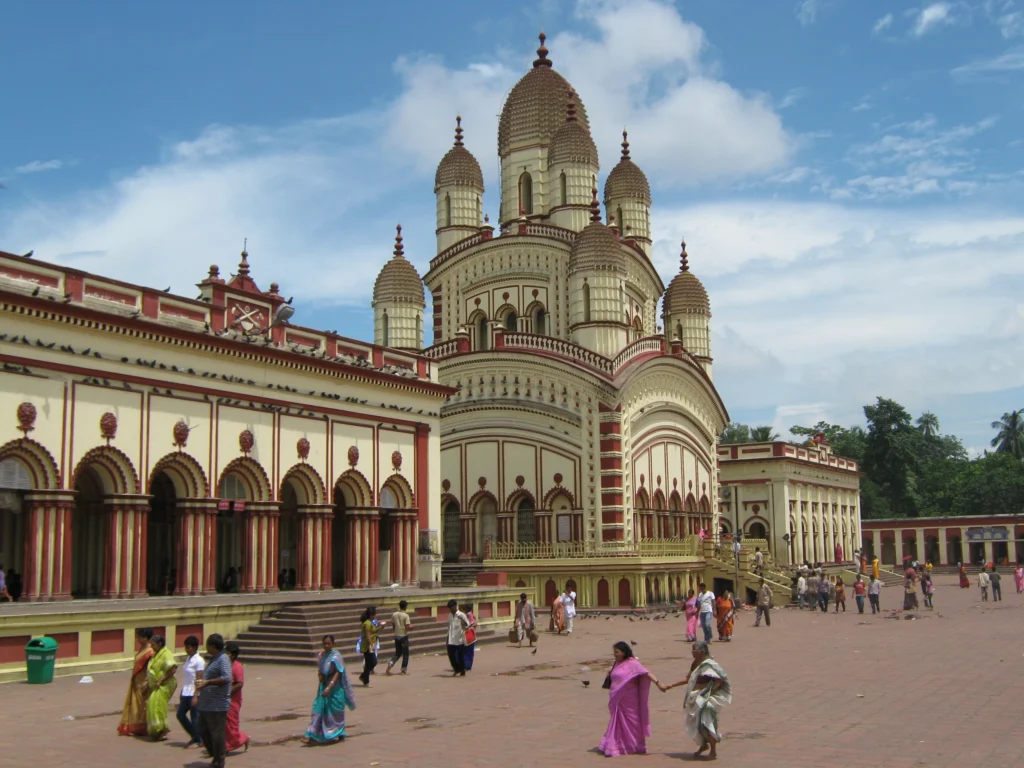
The main temple is dedicated to Bhavatarini, a form of Goddess Kali. It is built in the Navaratna (nine spires) style of Bengal architecture, standing on a high platform. The complex also includes twelve identical Shiva temples arranged in a row, a temple dedicated to Radha-Krishna, and a bathing ghat on the river.
The temple gained widespread fame due to its association with Sri Ramakrishna, who served as the chief priest. His spiritual experiences and teachings at Dakshineswar attracted numerous disciples, including Swami Vivekananda, who later spread his message globally. The temple complex was also home to Sarada Devi, Sri Ramakrishna’s consort and spiritual counterpart. The interactions, spiritual practices, and philosophical discussions that took place here significantly influenced the Bengal Renaissance and modern Hindu thought.
Visiting Dakshineswar is not just a religious pilgrimage for many; it’s also a visit to a place where profound spiritual history unfolded. The serene atmosphere, the architectural beauty of the temples, and the powerful spiritual vibrations make it a deeply moving experience. Its connection to towering figures of modern Indian spirituality firmly establishes it among the important historical places in West Bengal.
9. Hooghly Imambara, Hooghly: A Testament to Faith and Philanthropy
Located in Hooghly, a town with a rich colonial history itself, the Hooghly Imambara is a prominent Shia Muslim congregation hall and mosque. This impressive structure was built through the generous bequest of philanthropist Haji Muhammad Mohsin and was completed in 1861, decades after his death. It is a significant religious and historical place in West Bengal.
The Imambara is a two-storied building known for its striking architecture. Over the main entrance gate stands a tall clock tower, approximately 150 feet high. Visitors can climb the 152 steps to reach the top of the tower, which offers panoramic views of the surrounding area and the Hooghly River. The clock itself is a marvel of engineering, bought from the firm Black & Hurray Co. in London in 1852. It has two dials and three bells of varying weights, requiring two people to wind it weekly with a heavy key.
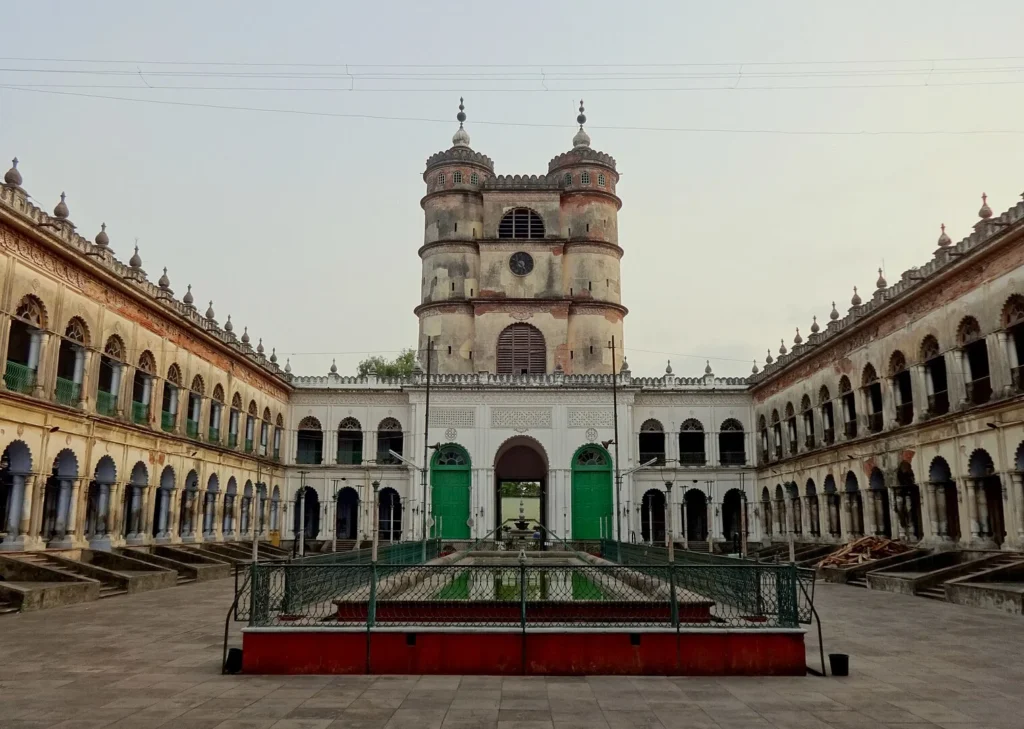
The mosque within the complex is adorned with intricate designs and calligraphic texts from the Quran engraved on the walls. The interior is decorated with marble, chandeliers, and hanging lanterns, creating a serene and beautiful space for prayer and contemplation. The central courtyard is spacious and peaceful.
Haji Muhammad Mohsin, the visionary behind the Imambara, was a wealthy merchant and philanthropist who inherited a large fortune. He dedicated his wealth to charitable causes, including the establishment of this Imambara and funding educational institutions. The Imambara stands as a lasting testament to his piety and commitment to the welfare of his community.
The Hooghly Imambara represents a specific facet of the historical places in West Bengal – the presence and contributions of the Muslim community and the impact of individual philanthropy in shaping the region’s heritage. It is a place of active worship and a historical landmark that showcases architectural beauty and a legacy of generosity.
10. Rabindranath Tagore’s Ashram, Santiniketan: A Hub of Culture and Education
While not an ancient ruin or a colonial monument in the traditional sense, Rabindranath Tagore’s Ashram in Santiniketan, Bolpur, holds immense historical and cultural significance, making it one of the most important historical places in West Bengal in the context of modern Indian history and the Bengal Renaissance. Founded by Rabindranath Tagore’s father, Maharshi Devendranath Tagore, as a spiritual retreat in 1863, it was Rabindranath who transformed it into a unique educational institution and a centre for art and culture.
Rabindranath Tagore established a school here in 1901, which later grew into Visva-Bharati University in 1921. His vision was to create an educational environment in harmony with nature, fostering creativity, independent thinking, and a global perspective. The educational philosophy at Santiniketan broke away from conventional Western models, emphasizing open-air classrooms, integrated learning of arts, humanities, and sciences, and a close connection with the surrounding rural community.
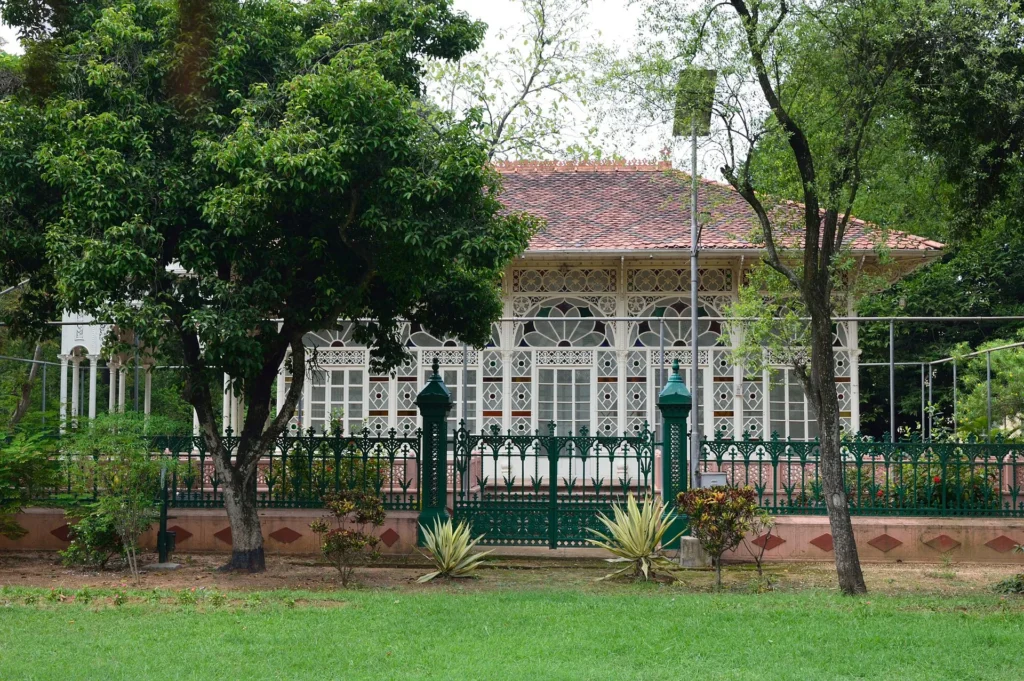
The Ashram complex includes several historical buildings associated with Rabindranath and his family, such as the Santiniketan Griha (the oldest building), Upasana Mandir (Prayer Hall, made of Belgian glass), and Uttarayan complex, where Rabindranath lived and worked. The Kala Bhavana (Institute of Fine Arts) and Sangeet Bhavana (Institute of Music and Dance) reflect Tagore’s deep commitment to the arts.
Santiniketan became a melting pot of ideas, attracting scholars, artists, and thinkers from India and abroad. It played a crucial role in the Indian independence movement and the shaping of modern Indian identity, influencing figures like Mahatma Gandhi and Jawaharlal Nehru. The unique blend of indigenous traditions and global influences fostered here had a lasting impact on education and culture.
Visiting Santiniketan is an experience of stepping into a vibrant cultural and intellectual legacy. You can see the simple, yet inspiring, surroundings where Tagore lived and taught, explore the art galleries, and feel the spirit of an institution dedicated to humanistic ideals. It represents a significant chapter in the history of education and culture, making it a vital stop among the historical places in West Bengal.
Final thoughts
Exploring the historical places in West Bengal offers a profound journey through the various layers of the state’s past. From the grandeur of colonial Kolkata and the opulent courts of the Nawabs in Murshidabad to the intricate artistry of the Malla kingdom in Bishnupur and the ancient ruins of Gaur and Pandua, each site contributes a unique thread to the rich tapestry of Bengal’s history.
These historical places in West Bengal are more than just old buildings; they are custodians of stories, traditions, and transformations that have shaped the region’s identity and, indeed, the nation. They remind us of the dynasties that ruled, the empires that rose and fell, the cultural exchanges that took place, and the lives of countless individuals who lived through these eras.
Whether you are marvelling at the European elegance of the Victoria Memorial, getting lost among the thousand doors of Hazarduari Palace, deciphering the terracotta tales in Bishnupur, walking through the ancient gates of Gaur, contemplating spirituality at Dakshineswar, appreciating the philanthropy behind Hooghly Imambara, or soaking in the cultural atmosphere of Santiniketan, the historical places in West Bengal provide a tangible connection to history.
Plan your trip to these incredible sites and allow yourself to be transported back in time. The historical places in West Bengal offer not just sightseeing, but a deep, enriching experience that stays with you long after your visit. Come, explore, and witness the enduring legacy of Bengal’s fascinating past. These are truly historical places in West Bengal that you absolutely shouldn’t miss.











